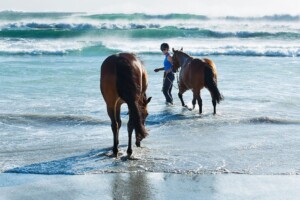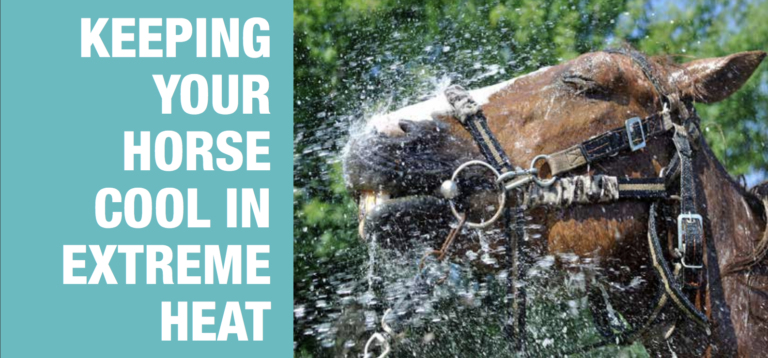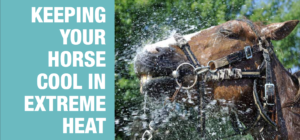Australia is known for its extreme summer temperatures, but while we have the luxury of air conditioners and fans, what about our horses? With heat stress a real danger, we offer you some helpful hints to get you through the cremation inducing temperatures.
Don’t work your horse in the heat
There’s a very sensible rule of thumb that states: If it’s too hot for you, it’s too hot for your horse. Unfortunately there are a few riders that will ignore this theory and will still work their horses in extreme heat.
What is often not recognised is that the shape of the horse and the way their internal organise lie, means that it’s not easy for them to disperse body heat. While they do sweat, their core temperature can still be high compared to their body surface temperature. Add on equipment such as saddle blankets and tack and this reduces the surface area where heat can be lost.
Another factor is that horses can also excessively sweat and become dehydrated, just like their human counterparts, so it’s important to have an electrolyte supplement close to hand.
As a general rule, if the humidity percentage plus the outside temperature equal 100, leave riding until the weather cools down, or for another day.
Don’t travel your horse in extreme heat
Bitumen and steel become hot and even though you may have great ventilation as you’re driving along with a float in tow, think about the risk factors. If there is an accident you may be stuck in traffic, so weigh up the pros and cons and made an educated decision. If you think it’s too hot to travel then avoid it all together or move your horse in the cooler parts of the day.
Provide plenty of water
Studies have shown that it’s a myth that horses can colic from drinking too much water. You’d be doing more harm than good withholding drinks so allow your horse to have plenty of cool, fresh water when they need it. Bonus points if there is a stick or object in their water trough that will allow wildlife to escape if they fall in. Birds and other animals feel the heat too and will often use troughs to cool down and wet their whistle but be unable to escape if they fell in. Having an item that they can climb onto to scape will prevent drownings.
Add salt and electrolytes
Like humans, horses lose salt when they sweat even standing in the paddock will cause salt loss. A good rule of thumb to remember is that a horse needs a minimum of 10 grams of salt per day per 100 kilograms of their weight. So, if your horse weighs 500 kilos, feed 50 grams of salt into their feed. Your horse may need more should you be working them hard or they run hot and sweat a lot. Some mixed or complete feeds do offer added salt, however it’s best if you control the salt levels yourself as there are varying factors in complete feeds. Always have a salt block on hand for your horse to lick as well.
Electrolytes are also important to horses, they are minerals that the body use for healthy functioning muscles and the transportation of nutrients and waste products in and out of cells. Electrolytes are made up of sodium, chloride, potassium, calcium, magnesium, phosphorus, manganese, and copper and can be extruded via urine and sweat on hot days and via intensive workouts.
There are plenty of electrolyte supplements on the market and they are easily added into your horses water or feed.
Cool your horse down
A hose down will help your horse cool down and scraping will assist the excess water to evaporate. Who doesn’t love a cold shower on a hot day? To avoid shocking your horse with the water, make sure you start hosing from the feet up. Sponging with a wet sponge or cloth will also feel nice.
Don’t cover your horse
As mentioned above, horses need to disperse the heat and covering them up can limit the ability to disperse the heat from their bodies. While naked is best, flies and insects could pose another problem, so a light rug (such as a flag combo) is a great option. While lots of rugs may have mesh, the heaviness of the material and plastic may hinder cooling.
Have some shade available
Adequate shelter options on hot days are the perfect way for horses to get out of the sun and have a cooler place to relax. While a shelter is ideal, trees offer brilliant shade options for horses to stand under. If the paddock is barren, a quick fix is to hang a shade cloth or erect a temporary shelter such as a marquee just make sure it can’t blow away or cause injury.
Keep the air moving
If your horse is in a stable, keep the air moving with a fan. There are plenty of options on the market that can be hung on beams and pointed into stables some even have mist sprays that will help to keep the skin cool. If hanging one isn’t an option, a pedestal fan that can be pointed in the direction of the horse would certainly help. Keep the fan oscillating as horses don’t always stand in the same spot and obviously make sure blades and cords are out of reach.
Offer sunburn protection
Horses can get sunburned, especially those with pink skin. While using human sun screen is an option, it does wear off and will need to be reapplied. There are longer lasting items on the market designed specifically for horses so check out your local saddlery or equestrian warehouse. If applying products isn’t an option, why not look into wearable protection such as a cover for the eyes and nose? There are lots to choose from on the market with different quality materials and price tags.
When in doubt, call for help
Hot weather can negatively affect horses and heat can pose real dangers to their health. If you suspect that your horse is suffering heat related stress, call the vet immediately. Panting, increased breathing or heart rate as well as increased sweating or worse – no sweating – are all indicators that your horse may be in distress. Follow veterinarian advice and do what you can to keep your horse cool and comfortable.





